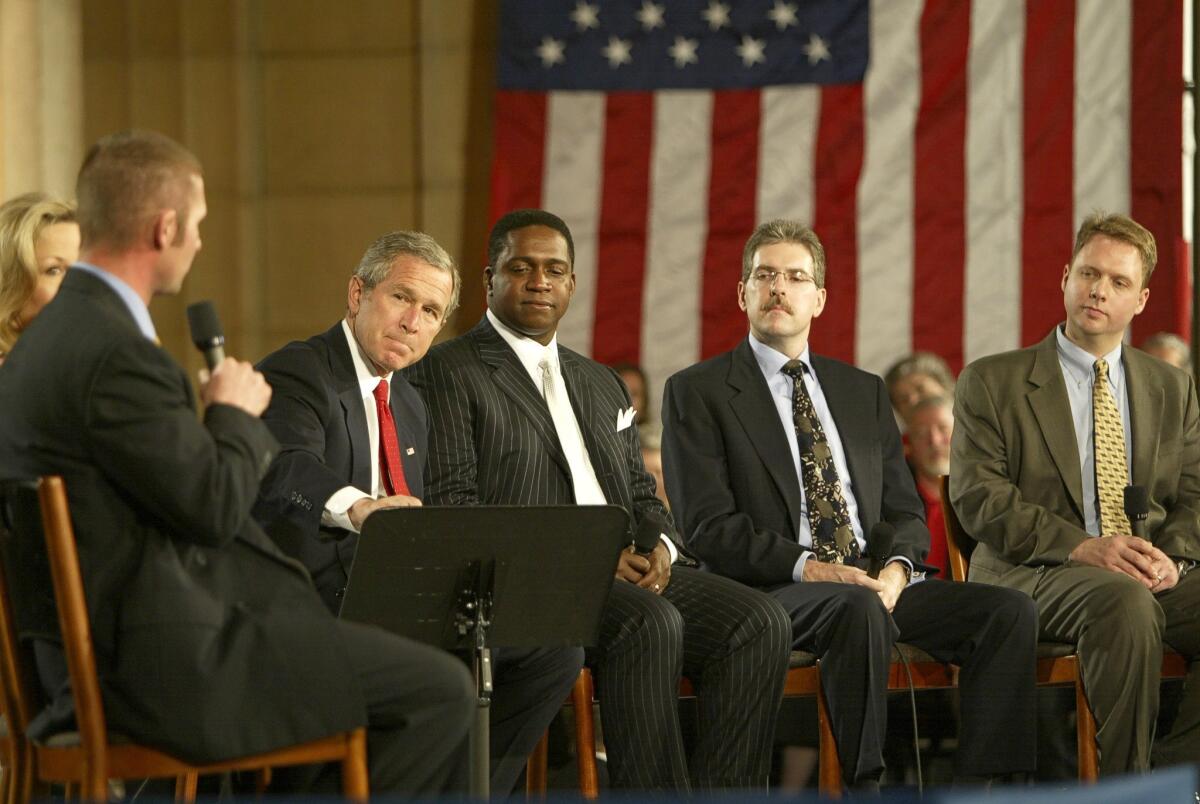The conservative case against expanding Social Security? It was based on a math error

American Enterprise Institute fellow Andrew Biggs, far right, in 2005, when he worked on President George W. Bush’s failed Social Security privatization campaign.
- Share via
The conservative argument that the retirement crisis is a myth has been based on the notion that Americans actually will have far more in retirement resources than they recognize — particularly that Social Security benefits will amount to a much larger percentage of workers’ lifetime income than has been assumed. Ergo, there’s no need to expand Social Security to give retirees more.
Now it turns out that this assumption is based on an arithmetic error. On Wednesday, the Congressional Budget Office, whose extremely generous estimates of the so-called replacement rate from Social Security fueled the conservative position, fessed up. The CBO says it miscalculated the replacement rates in its long-term projection for the program issued in mid-December. It has now reissued the report with corrected figures, showing a “substantially lower” replacement rate for retirees.
To take just one example, the CBO reported in December that for the average retiree born in the 1940s, Social Security benefits would replace a healthy 60% of average late-career earnings. The new figure is only 43%.
This is a big problem for conservatives such as Andrew G. Biggs of the American Enterprise Institute, who made the CBO’s original calculations a linchpin of his campaign against expanding Social Security. Last month, we examined Biggs’ work on this theme — three articles appearing since mid-December in Forbes, the Washington Post, and the Wall Street Journal, asserting that the retirement crisis is “phony” (to quote the Journal’s headline). Via Twitter, he has now retracted the Forbes piece. He says retractions of the others are coming.
[Update: Biggs says by email that he has sent a retraction to the Wall Street Journal. His Washington Post piece, however, didn’t cite the original CBO figures directly.]
Biggs told me by email that the CBO’s recalculation “doesn’t radically alter the way I view the adequacy of Social Security benefits or retirement saving.” That’s because he had argued for a different formula that he says still shows replacement rates close to the CBO’s original figures.
Still, he relied explicitly on the CBO’s previous figures to make his case not only against expanding Social Security, but for cutting benefits. As he wrote in the Journal: “Every Democrat running for president has pledged to increase Social Security benefits, on grounds that Americans’ retirement savings are inadequate.... Republicans in the race instead focus on restoring Social Security to solvency — by reducing benefits for high earners or raising the retirement age.” The CBO’s data, he argued, “suggest that the Republican approach is better grounded.”
The CBO’s recalculations dramatically undermine the argument that with Social Security as a foundation to their post-career income, retirees will do just fine. As Biggs had noted, personal finance experts generally say that it takes 70% of one’s working income to maintain a lifestyle in retirement — in other words, someone earning a salary of $70,000 would need about $49,000.
Social Security has served to provide retirees with a sizable piece of that income. Its benefit structure is broadly progressive, giving lower-income workers a higher replacement rate than middle- or high-income retirees, on the assumption that lower-income folks have fewer additional resources such as an employer pension or savings and investments.
The CBO’s original calculations in December implied that Social Security gave retirees much more of a head start than anyone previously had figured — in fact, for some workers more than they needed. Low-income workers born in the 1960s, the CBO reckoned, would get 95% of their pre-retirement earnings from benefits.
The CBO calculated its figures from averaging together the last five years of “substantial earnings” before age 62, defined as earnings “that were at least half of a worker’s average indexed earnings, adjusted for growth in prices.” The agency now says it inadvertently included earnings that were below that threshold, resulting in higher calculated replacement rates. It now says that those low-income workers born in the 1960s would get only 63%. That’s a big difference — the workers now are seen not to be receiving more than they need, but not quite as much as they need.
As we observed last month, “replacement rates are notoriously slippery.” Among other factors, the CBO’s original figures were based on a novel standard. Instead of measuring Social Security benefits against retirees’ lifetime earnings, including years of low earnings at the beginning and end of one’s career, the new standard measures benefits only against workers’ substantial earnings late in life. We called that “a better benchmark to judge the difference in lifestyle pre- and post-retirement.” But of course the key is doing the math correctly.
In any case, Social Security’s chief actuary estimated a much lower replacement rate than the CBO for middle-income retirees — in the neighborhood of 39%. The CBO’s figures are now much more in line with Social Security’s, solving the mystery of why their numbers had diverged so much.
And the bottom line is now sharper than ever: With retirees facing dwindling alternative resources, Social Security is needed to pick up more of the slack. And for that it needs to be expanded, not reduced.
Keep up to date with Michael Hiltzik. Follow @hiltzikm on Twitter, see our Facebook page, or email michael.hiltzik@latimes.com.
MORE FROM MICHAEL HILTZIK
Another executive gets his wrist slapped for poisoning a community’s water
The billion-dollar CRISPR patent battle: A case of big money shaping science
Apple takes its eye off the ball: Why Apple fans are really coming to hate Apple software
More to Read
Inside the business of entertainment
The Wide Shot brings you news, analysis and insights on everything from streaming wars to production — and what it all means for the future.
You may occasionally receive promotional content from the Los Angeles Times.











